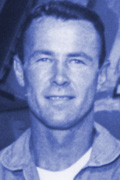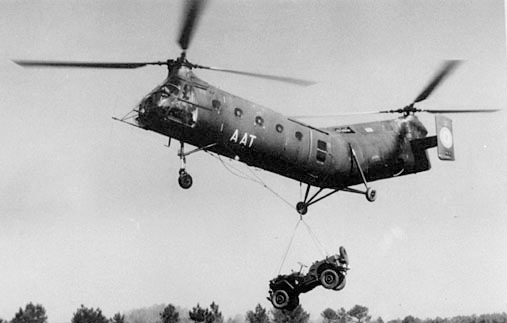Chapter 4 >
Autobiography home >
NF-104 home

|
Chapter 4 - Approach to Space click on the links below for more of the story... i. Test Pilots & Operations - ii. Experimental Testing - iii. F5-A Freedom Fighter - iv. Variable Dynamics - NF-101A - v. Anchors Aweigh - vi. Two Strakes - One Strike! - vii. Whirlybirds, Spinning Wings? - viii. The Rest of the Story |
||
Whirlybirds, Spinning Wings?Our next-door neighbors were Phil and Barbara Neale, who had five children. Phil had been a test pilot but was stricken, from a sore throat, with a streptococcus infection that attacked his heart. He was permanently grounded, with no further recourse.
I decided to call again on a friend of mine, Dr. Larry Lamb. Larry, a “big-wheel” in Air Force medical service had saved me from losing my opportunity to the greatest testing experience in my life, the Aerospace Trainer. I knew if anyone could overturn the decision it was he, so I asked him to visit us as a special favor. He flew in from San Antonio, and was our dinner guest at home, along with the couple next door, Phil and Barbara. Martha couldn’t boil water as my wife at age 18, but she had gotten close to gourmet ranking by that time and higher still, now; after 13 years in New Orleans, post A.F. retirement. I hoped that good company and good food would fill the bill and Phil and Barbara were grand folks. Phil told Larry all about his permanent grounding and how much he loved to fly. Larry Lamb arranged for an examination in San Antonio and Phil was reinstated to flight status.
Later, after my experience in an H-21 helicopter with Phil Neale, during the emergency recovery of Chuck Yeager, who crashed one of the AST rocket airplanes we were flying, I decided to learn to fly those strange contraptions. We had flown a few simulations on hovering aircraft in the ARPS and the real deal piqued my interest. I knew that Phil had been a fine fighter pilot who had become our leading helicopter test pilot. He agreed to teach me and I flew with him every chance I had.
We had access to the Test Operations H-21 that we picked Yeager up in so that is how I learned, and a good choice it was. It was far more difficult than any others that I flew later. Except during hover and the transition from flight to hover, a helicopter is controlled like an airplane. But, in the case of the H-21, a bent banana, with the twin-rotor fore and aft, it was a treacherous airplane. It was very low powered to the point of danger in emergency procedures, even when practicing. And was an unusually unstable aircraft. A slight stick pulse in roll with hands off would result in a fatal rollover in a couple of rapid natural roll responses, if the pilot didn’t grab quickly and correct. One never let the control stick out of hand in that chopper, because there was no such thing as roll trim.
It was equally critical on rotor speed, which was to be 280 revs per minute at all times. Fortunately, the human ear soon tuned in to the sound of that rpm and it was not necessary to check the gauge every few seconds, but it was while learning, adding to the angst. You had better never stall out the rotor blades, without a lot of altitude to spare.
Modern jet choppers (my last flight of any sort, 20 years after my last A.F. flight was piloting an Apache on a simulated low-level cross FLOT night attack) have auto-power and rpm control and power to burn. In conventional choppers, especially during hover, all of that had to be pilot controlled, with the throttle and collective pitch at work by the left hand controls to maintain rpm and ascent/descent, while the stick controlled variable pitch for steering direction (forward/aft and right/left), in combination with the rudder pedals (rotation).
Phil and I began to have great competitions at the old south base. One contest was to have the crew chief lean out the side door and tell us when one main wheel was over a mark on the ramp, while hovering at a few feet. The objective was to rotate 360 degrees while maintaining the height and keeping that wheel directly over the spot. The difficulty was that we couldn’t see spot or wheel and our center of rotation to achieve it was not the normal one. It meant constantly moving forward or aft, as well as sideways, all precisely coordinated with the rotation.
The most demanding, and dangerous, challenge was flying 180-degree auto-rotation landings, with the collective full down (idling engine). The autorotation is the only way to survive power failure in a chopper and meant maintaining the rotor speed by steep diving. The H-21 required a fairly steep dive for a straight approach, but with the necessarily tight 180 degree turning autorotation it got very steep, in order to maintain critical 280 rpm. The hairy part was the simultaneous combination of roll out and pullout precisely in line with landing and terminated at ground level, because every bit of rotor energy was necessary to avoid hard landing and misjudgment would have meant a real crash. The lack of engine power and acceleration made a practice equivalent to a real emergency landing once you got close to touch-down.
There was little if any risk to practice dead-sticks in fighters, but not so in the H-21 autorotation. It is my experience that this maneuver, in practice was more risky than an actual dead stick in an F-104, noted also for a steep descent.
Phil Neale was a great guy and fine instructor for me, plus being friend and neighbor, with a beautiful and gracious wife and bundle of neat kids. Phil perished in the crash of a new French helicopter, Dassault as I remember, that he was flying for test and evaluation, but those years in between were extremely happy ones for him. I know it was the life he was prepared to die for, just to live it!
Flying new airplanes always added the excitement of new experiences. After I learned to fly helicopters, Jack Woodman, Lockheed test pilot, arranged for me to fly a small experimental Lockheed experimental helicopter that was the first successful rigid rotor, the XH-51. It flew like a tiny fighter, capable of acrobatic maneuvers that I never again experienced in flying a helicopter until I flew the Apache, also rigid.
|
| previous section | next section |

